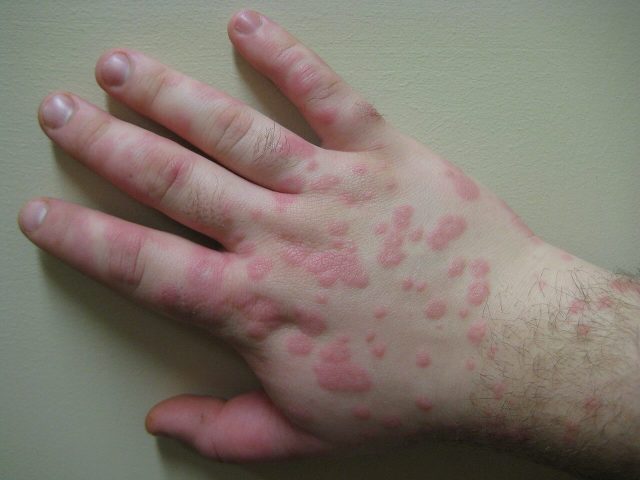Lyme Disease Rash That Appears on My Side and Back Circular

There are several types of erythema, and it can appear on all parts of the body in different patterns and variations of color such as red, purple or brown. Some forms of the rash may cause blisters that burst and lead to sores.
Causes, symptoms and treatment depend on the type of erythema. Milder cases go away in a few days or weeks without treatment. More serious cases require medication or hospital care.

An example of erythema multiforme, the most common type of erythema.
Photo Credit: James Heilman, MD
Erythema Multiforme
Erythema multiforme (EM) is the most common type of erythema. Viral and bacterial infections cause it. Two of the most common causes are Herpes simplex virus (HSV) type 1 and 2 and Mycoplasma pneumoniae infections.
More rarely, it can be a reaction to a drug or vaccine, according to The National Library of Medicine.
Medications that may cause EM include:
- Gout medication called allopurinol
- Some antibiotics (aminopenicillins, sulfonamides)
- Anti-seizure medications
This rash typically affects people between the ages of 20 and 30. Twenty percent of people who get it are children.
There are no blood tests for EM, and doctors diagnose it by looking at it. But in some cases, they may do some tests to rule out other diseases.
Types
There are two types of EM, minor and major.
Erythema multiforme minor (EM minor) typically occurs on the peripheral parts of the body, such as the fingers and toes. Rarely, it may manifest as light mouth sores. It usually clears up on its own.
Erythema multiforme major (EM major) skin lesions are more extensive and serious. These are more likely to be caused by a drug reaction than an infection. For this reason, EM major may also be known as Stevens-Johnson Syndrome (SJS), a potentially life-threatening skin rash caused by a medication.
Unlike EM minor, EM major causes extensive, blistering sores on the lips and in the mouth. They can also appear on the eyes and genitals.
Symptoms
A person with EM may have all or some of the following symptoms and they may range from mild to severe.
Symptoms include:
- Circular, red bumps on the soles, palms, arms, face and legs that grow into circles that may look like targets
- Itchiness, in some cases
- Painful sores or blisters on the lips, mouth, eyes and genitals
- Red patches with pale rings inside the patch with purple centers and small blisters called target lesions
- Fever
- Joint pain
Treatment
EM usually goes away on its own in a few weeks. EM major takes longer to go away. Doctors often recommend topical corticosteroids and anesthetics to control symptoms. If there are sores in the mouth, doctors may recommend a mouthwash.
Symptoms may go away and come back. If doctors suspect herpes flares cause the EM reoccurrences, they may prescribe antiviral therapies such as acyclovir or valacyclovir.
Erythema multiforme major is more serious and requires hospital care with intravenous fluids and supportive care.
Erythema Nodosum
Erythema nodosum appears as red, tender bumps that appear on the shins. Most nodules appear on the lower extremities. Reactions to a disease or medication are the main causes.
Overall, this rash affects one to five in 100,000 people.
It can occur at any age, but most often affects people between the ages of 20 and 30. Streptococcal infections are the most common cause among children. Drug reactions, hormonal reaction and inflammatory bowel disease are among the most common causes in adults.
In addition to red bumps, symptoms include fever, joint pain and enlarged lymph nodes in the chest.
This condition is not typically serious, and it goes away in about six weeks, according to Johns Hopkins Medicine. Treatments include corticosteroids, antibiotics, nonsteroidal anti-inflammatory medicines (NSAIDs) and bed rest.
Erythema Marginatum
Erythema marginatum is a skin rash that typically appears on the limbs and trunk of the body. It can appear as a pale, pink center with a darker red outline.
These spots are typically round, but can be irregular or elongated shapes. They aren't usually itchy or painful.
It most often occurs in response to rheumatic fever. Other causes include Lyme disease, allergic reactions to drugs or hereditary angioedema.
The rash typically fades on its own, but doctors may prescribe medications for any underlying diseases.
Erythema Toxicum
Erythema toxicum or erythema toxicum neonatorum is a common skin rash that affects about 40 to 70 percent of full-term newborns, according to American Family Physician. It can happen at birth, but most babies get it in their second or third day of life.
It appears as pustules surrounded by blotchy patches of redness, often described as a "flea-bitten" appearance. These pustules may be filed with fluid, but it doesn't indicate infection. The rash can occur anywhere on the trunk, face and extremities, but the soles and palms are not involved.
Doctors don't know what causes the condition, but it's not serious and typically fades over five to seven days without treatment. Sometimes it can reoccur.
Fifth Disease
Erythema infectiosum is also called fifth disease. It's a mild rash caused by parvovirus B19, and is more common in children.
The most noticeable feature is a red rash on the face sometimes called "slapped-cheek" rash, according to the Centers for Disease Control and Infection. It appears within 14 days after parvovirus infection.
Other symptoms include fever, headache and runny nose. The rash may spread from the face to the neck, chest, buttocks, legs, arms or soles of the feet a few days after getting it on the face. People with fifth disease may also experience joint pain lasting for one to three weeks. In some people it can last for months or longer, but it doesn't cause long-term problems.
Symptoms typically go away within seven to 10 days. Treatment includes supportive care to relive itching, fever and swelling.
Palmar Erythema
Palmar erythema is a red rash on the palms and sometimes on the fingers. It is slightly warm but not painful or itchy. It occurs on both hands. It can get redder with changes in temperature, pressure on the palm, emotional states or hand elevation.
This condition is caused by pregnancy, underlying disease or reactions to medications. Depending on the cause, it is referred to as primary palmar erythema or secondary palmar erythema.
Causes of primary palmar erythema include:
- Heredity
- Unknown allergies or causes
- Pregnancy – It occurs in about 30 percent of pregnant women
Causes of secondary palmar erythema include:
- Autoimmune diseases, such as rheumatoid arthritis
- Diabetes
- Drug reactions
- Infections and diseases such as cancer, chronic obstructive lung disease
- Liver disease
- Thyrotoxicosis
There is no treatment for palmar erythema. Doctors will test you for underlying diseases that could be causing it and recommend treatment for those health issues. If they think a drug caused the rash, they may recommend stopping that treatment.
Erythema Chronicum Migrans
Erythema chronicum migrans, or erythema migrans, is a skin rash that occurs in people with early Lyme disease, a disease caused by the bite of an infected tick. Erythema migrans begins at the site of the tick bite in about 70 to 80 percent of people infected with Lyme disease, according to the CDC.
On average, the rash appears about seven days after a tick bite, though it can appear anywhere from three to 30 days at the site of the tick bite.
The rash gradually expands, forming a red spot surrounded by a bigger red ring, like a bull's-eye. The rash can expand up to about 12 inches across. But sometimes it appears as a red patch with central hardening and blistering. The color intensity ranges from light pink to a deep purple.
This type of rash is rarely painful, but can be sensitive and warm to the touch as well as itchy. A person with this rash may also experience other symptoms of Lyme disease such as joint aches, headache, fever and chills.
There is no specific treatment for erythema migrans, except for supportive care to control itching. If Lyme disease is treated with antibiotics, the rash usually goes away in a few weeks.
Erythema Ab Igne
Erythema ab igne is an uncommon rash caused by repeated exposure to infrared radiation or direct heat to the skin. Sources of heat include warm water bottles, heating pads, laptop computers and space heaters.
The lesions appear like mottled, mildly pink patches and then turn red or violet, then brown. These patches form lace-like or fishnet patterns. They don't usually cause symptoms but can itch, burn or cause pain.
Treatment consists of removing the heat source that could be causing the rash. Mild cases can go away in a few months. But more advanced cases may linger for years or be permanent. In these cases, treatment includes tretinoin, 5-fluorouracil or laser therapy to improve appearance.
Rarely, erythema ab igne may lead to cancer. A dermatologist should monitor the rash and may recommend a biopsy for long-lasting rashes.
Erythema Annulare Centrifugum
Erythema annulare centrifugum (EAC) is a rare skin rash characterized by tiny, red bumps spreading out from a central patch of skin. They may form irregular shapes, but more often they form a circular, ring-like pattern.
EAC most often affects the thighs or legs. It is more likely to occur in mid-life, but there have also been reports of the rash in infants.
Researchers aren't sure what causes this rash, but it has been associated with fungal infections, viruses and bacteria. Some medications and foods may also trigger it.
Rarely, EAC can happen when the immune system has an abnormal response to cancer cells called a paraneoplastic phenomenon. In these cases, it's referred to as paraneoplastic erythema annulare centrifugum eruption, or PEACE. This is more common in females.
If a doctor suspects PEACE, he or she will test for cancer. Some cancers associated with EAC include lymphoma, leukemia, solid tumors and lymphoproliferative disorders.
Lyme Disease Rash That Appears on My Side and Back Circular
Source: https://www.drugwatch.com/health/rash-and-skin-disorders/erythema/